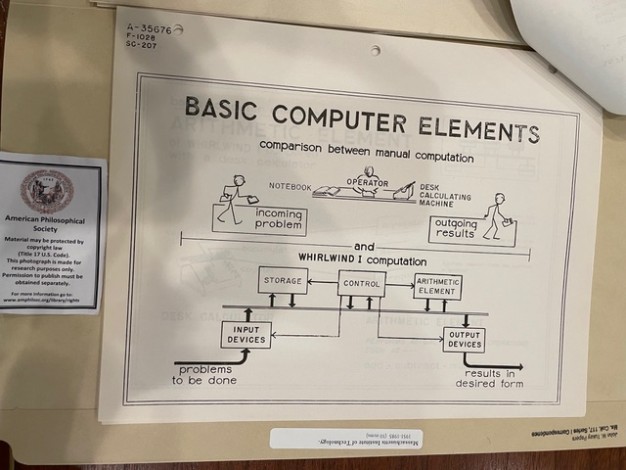Featured Fellow: Magnus Schaefer (2024-2025 William T. Golden Short-Term Fellow)
The Library & Museum at the American Philosophical Society supports a diverse community of scholars working on a wide-range of projects in fields including early American history, history of science and technology, and Native American and Indigenous Studies, among others. Read on to learn more about some of our fellows and their research at the APS. Additional information about our fellowship programming and other funding opportunities can be found here.
Briefly describe your research project.
Digital signal processing comprises techniques for transforming and analyzing sound, images, and other media; it forms the technological base for many contemporary applications, such as video telephony and medical imaging. My dissertation charts a historical trajectory spanning from the introduction of digital computers for industrial uses in the early 1950s to the emergence of digital signal processing as a distinct branch of electrical engineering in the late 1960s. Expanding upon existing historical scholarship on the early digital era, which tends to focus on military research, office machines, and telephony, I discuss the development of inherently digital approaches to interpreting signals in exploration geophysics, seismology, and communication engineering and examine how the objectives and professional cultures of these fields have shaped signal processing techniques and practices.
What collections did you use while working at the APS?
I mainly focused on the John W. Tukey papers. Tukey (1915–2000) was a statistician who held dual positions at Princeton University and Bell Laboratories (the research and development arm of the telecommunications company AT&T) for most of his career. He regularly collaborated with other scientists and was a highly sought-after advisor, working for the US government and military as well as for many companies across a range of industries (e.g., Educational Testing Service, Monsanto). His career is well documented in his correspondence, collections of thematic reference materials, and published and unpublished papers. Tukey’s methods for the analysis of statistical time series (collections of data representing the variations of a phenomenon over time) were a key element in the development of digital signal processing from the very start, even before scientists and engineers began using electronic digital computers for analyzing time series in the early 1950s.
In 1965, Tukey and the IBM researcher and programmer James W. Cooley published the Fast Fourier Transform (FFT) algorithm, which significantly sped up fundamental signal processing calculations and acted as a catalyst for the emergence of digital signal processing as a kind of general-purpose “toolbox” for many different disciplines. The collaboration between Tukey and Cooley was initiated by Richard L. Garwin, of IBM. The APS has Garwin’s papers, too; in the mid-1960s, Garwin fervently promoted the potential of the FFT algorithm in numerous letters to IBM senior management and to his peers in the U.S. scientific community. These letters are important for my research, as they document that the FFT didn’t just catch on immediately: This process required mediation and translation through peer networks, hardware, and commercial successes.
What’s the most interesting or most exciting thing you found in the collections?
The Richard L. Garwin papers! They are still being processed and not yet included in the APS online catalog. I had been looking for them for a while, without success, so I was thrilled to learn that they are at the APS. I am deeply grateful to the archivists who went above and beyond to make relevant subcollections of the Garwin papers available to me.
Do you have any tips or suggestions for future fellows or researchers?
The archivists at APS are wonderful. It was through talking to them about my research that I found out about the Garwin papers.
Any suggestions for must-see places or things to do in Philadelphia?
Wissahickon Valley Park is a great place for hikes. It’s northwest of the city but easy to reach with public transportation. There are several miles of trails and a restaurant with a nice porch, Valley Green Inn.

